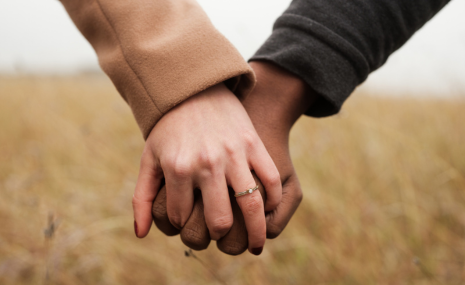Celebrating the 50th anniversary of the right to interracial marriage

Richard and Mildred Loving! These are names most interracial couples will never forget. As is, the Loving couple made it possible for interracial couples to marry in the United States. The issue was mainly between black and white marriages. But because of their fight for love, on June 12, 1967, the U.S. Supreme Court withdrew the law against interracial marriages in 16 states.
For this to happen, Richard and Mildred were jailed for loving each other. And today marks the 50th anniversary since the court's ruling.
Find your soulmate on LatinoLicious










The couple lived happily with their three kids. This was until the unfortunate car accident that took Richard's life. Mildred lived on the down low after that. She never remarried.
In 2007, she did an interview with the Associated Press to mark the 40th anniversary of the Supreme Court's ruling. And according to her, it wasn't publicity that made the couple go the extra mile. They fought for the right to love. This is one of those stories that change the world.
Below is the full interview, as was reported by Dionne Walker:
Reporters no longer beat a path to the modest white house just over the Caroline County border — and that's fine with its owner, a soft-spoken 67-year-old who never wanted the fame that her marriage brought her.
Born Mildred Jeter, she's mostly known by the name she took when she — a black woman living in segregated Virginia — dared to break the rules by marrying a white man named Richard Loving.
The union landed the Lovings in jail, and then before the U.S. Supreme Court, and finally in the history books; 40 years ago Tuesday, the court ruled in favor of the couple, overturning laws prohibiting interracial unions and changing the face of America.
Mildred Loving is a matriarch to thousands of mixed couples now sprinkled in every city. But she hardly considers herself a hero — just a girl who once fell in love with a boy.
"It wasn't my doing," Loving told The Associated Press, in a rare interview. "It was God's work."
While the rest of the Jim Crow South struggled to divide the races in the early '50s, blacks and whites in tiny Central Point had long been intertwined. They worked together on farms, raising chickens and tobacco. And often, they were intimate, explained Edward Clarke, who grew up in the town an hour outside Richmond, today little more than vast fields, ragtag homes and weed-choked farm houses.
Standing in the hilly cemetery which Richard Loving is buried, he swept his hand out over the markers reading Jeter, Byrd and Fortune — black folks, he explained, many so pale they could pass for white.
"The white people were just like the black people," said Clarke, a black man. "You lived and survived ... it was a sharing thing."
It was in this setting that a skinny 11-year-old nicknamed "Bean" met a 17-year-old boy who was a family friend, according to Phyl Newbeck, a Vermont author who detailed the case in the 2004 book, "Virginia Hasn't Always Been for Lovers."
Over the years, friendship led to courtship — but their relationship took an abrupt turn when an 18-year-old Mildred became pregnant.
"We're talking the early '50s, when an illegitimate child was far more of a stigma," Newbeck said. "I don't think Richard wanted her to have to bear that."
And so, they drove some 80 miles to Washington, D.C., in 1958, married and returned to Central Point to start a new life.
"I think he thought (if) we were married, they couldn't bother us," Mildred said.
Within a month, they were in jail.
Now 84, then-Sheriff Garnett Brooks vividly recalls bursting into the Lovings' home at 2 a.m., rousing the couple out of their sleep and hauling them off to face the law. Word of their marriage — nobody's sure who complained — had reached the commonwealth's attorney.
"He told me to go and check on them and if they are (married), arrest them," said Brooks, who insists the case wasn't about race but about illegal cohabitation. "I told him I'd be glad to do it."
A 28-year-old Phil Hirschkop was just a few months out of law school when he overheard a profession discussing the Lovings with another lawyer, Bernard Cohen.
It was 1964, and the Lovings had spent the past few years living in exile in Washington after being convicted on charges of "cohabitating as man and wife, against the peace and dignity of the Commonwealth," according to their indictments. Laws banning racially mixed marriages existed in at least 17 states.
The couple had avoided a year in jail by agreeing to a sentencing mandating, "both accused leave Caroline County and the state of Virginia at once, and do not return together or at the same time to said county and state for a period of 25 years."
They got around it, recalls University of Georgia professor and family friend Robert Pratt, by riding back in separate cars and meeting up.
The frustrated young wife had written to then-Attorney General Robert Kennedy, who referred her to the ACLU for help returning to their Virginia home permanently. Cohen filed a motion to vacate the 1959 sentence against the couple, but hit a dead end when the courts refused to respond.
American courts had proven tough on race-mixing in the past: A handful of cases similar to the Lovings' had come up before in other places, but were stuck in a thicket of state-sanctioned racism and red tape.
But lawmakers had just passed the Civil Rights Act, and across the South, blacks were defying Jim Crows' hold.
Hirschkop was convinced the Supreme Court was ready for change, too — but the right case had to come before the justices, free of any legal loopholes the state could seize upon. The Lovings presented such a case.
Hirschkop argued that the laws must treat each citizen equally, and that "when a law is based on race, it is immediately suspect and the burden is shifted to the state to show there is a compelling interest to have that sort of racial differentiation."
On June 12, 1967, the court agreed.
"The country was ready, the Supreme Court was ready ..." Hirschkop said. "They were going to do the right thing."
Richard, by all accounts a stoic, blue-collar man content to let Mildred do the talking, moved his family into a small house on Passing Road, and tried to live happily ever after.
The ended when a drunken driver struck their car in 1975, killing Richard and costing Mildred her right eye. The small cemetery where he is buried a few minutes from their home.
Over the years, Mildred has granted few interviews, letting others tell her story through books, articles and a Showtime film, "Mr. and Mrs. Loving."
"Not much of it was very true," she said on a recent Thursday afternoon. "The only part of it right was I had three children."
Her hands are curled by arthritis and her right eye is just a lidded hollow now. Still, Mildred's face lights up as she talks about Richard. She thinks about him every day.
Each June 12, Loving Day events around the country mark the advances of mixed-race couples. Mildred doesn't pay much attention to the grassroots celebrations.
Mostly she spends time enjoying her family, two dogs, and the countryside she fought so fiercely to again call home.
She wishes her husband was there to enjoy it with her.
"He used to take care of me," said Mildred Loving. "He was my support, he was my rock."
Responses to "Celebrating the 50th anniversary of the right to interracial marriage"
Be the first to leave a comment
You must be logged in to post a comment.
















































